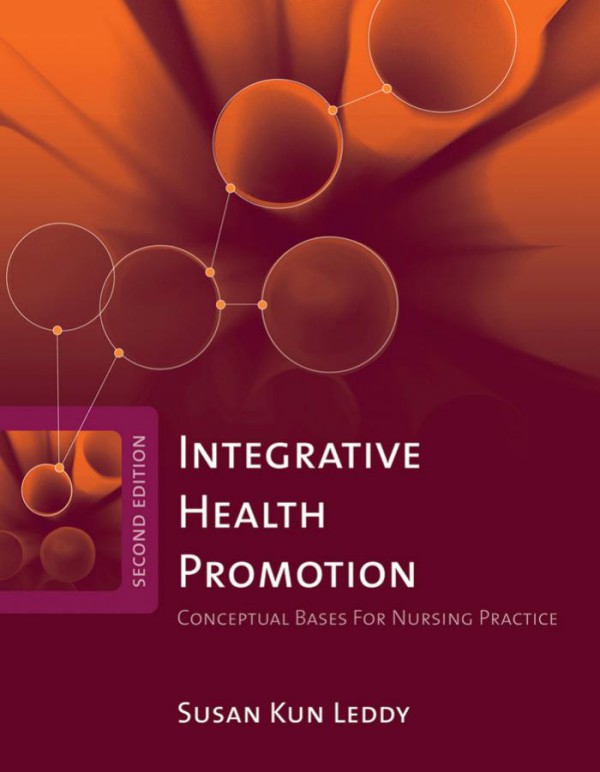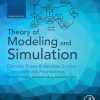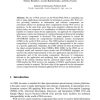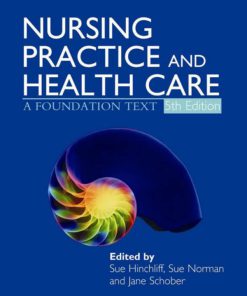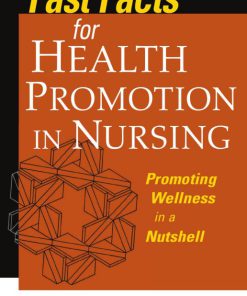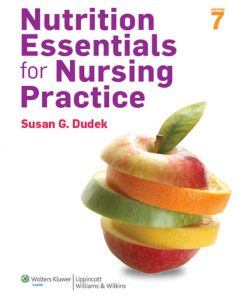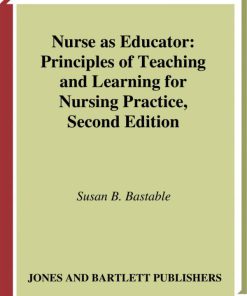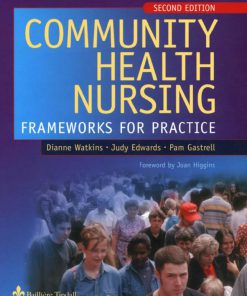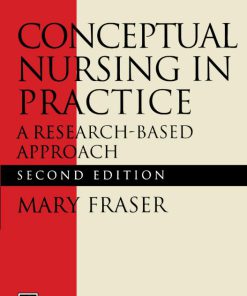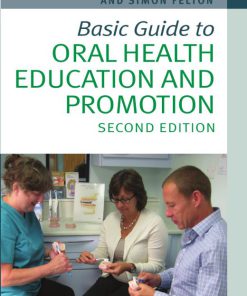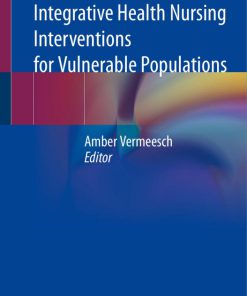Integrative Health Promotion Conceptual Bases for Nursing Practice 2nd Edition by Susan Kun Leddy ISBN 9781284044294 1284044297
$50.00 Original price was: $50.00.$25.00Current price is: $25.00.
Authors:Unknown , Author sort:Unknown
Integrative Health Promotion Conceptual Bases for Nursing Practice 2nd Edition by Susan Kun Leddy – Ebook PDF Instant Download/Delivery. 9781284044294 ,1284044297
Full download Integrative Health Promotion Conceptual Bases for Nursing Practice 2nd Edition after payment
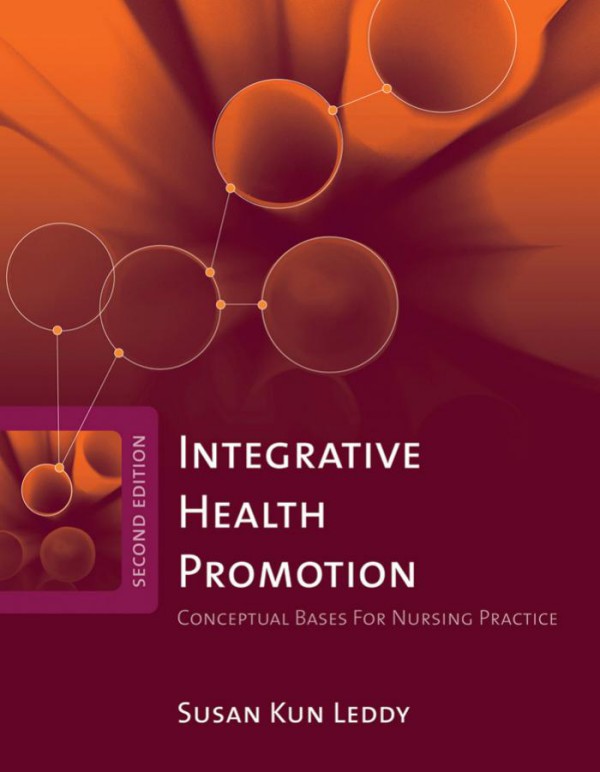
Product details:
ISBN 10: 1284044297
ISBN 13: 9781284044294
Author: Susan Kun Leddy
Integrative Health Promotion Conceptual Bases for Nursing Practice 2nd Edition Table of contents:
Section I Conceptual Bases of Health Promotion
1 Health, Health Promotion, and Healing
Abstract
Learning Outcomes
The Disease Perspective of Health
Ideas of Health Consistent with the Disease Perspective
Health
Disease
Illness
Sickness
Well-Being
Figure 1-1. The well-being continuum.
Health Protection And Disease Risk Prevention
Box 1-1 Healthy People 2010 Focus Areas
Health Promotion
The Individual (Behavioral) Approach
The Nurse’s Role in Promoting the Health of Individuals
Box 1-2 Nursing Roles in Health Promotion of Individuals
The Socioenvironmental (Ecological) Approach
Box 1-3 Suggested Nursing Approaches Consistent with the Socioenvironmental View
The Societal (Policy) Approach
Figure 1-2. A possible structure for health promotion (reprinted from Soc Sci Med, 41, Rutten, A. The implementation of health promotion: A new structural perspective, pp. 1627-1637. © 1995, with permission from Elsevier Science).
The Nurse’s Role in Societal Health Promotion
The Person Perspective of Health
Ideas of Health Consistent with the Integration Perspective
Healing
Definitions of Healing
Outcomes of Healing
Roles for Nurses in Healing
Characteristics of Nurse Healers
Conceptual and Theoretical Approaches to Healing
Table 1-1 Comparisons Between Health Protection, Health Promotion, and Healing
Holistic Nursing Practice
Box 1-4 Selected Characteristics of Holistic Nursing
Advantages of Holistic Nursing Practice to Promote Healing
Integrative Health Promotion
Chapter Key Points
References
2 Health Strengths
Abstract
Learning Outcomes
The Strengths Perspective
The Theory of Healthiness
Figure 2-1. Empirically derived components of healthiness (© Copyright by Susan Kun Leddy, 2005. Permission to use granted by the copyright holder).
Meaningfulness
Goals
Connections
Capability
Control
Choice
Challenge
Confidence
Capacity
Chapter Key Points
References
3 The Meaning of Health: Health Care Belief Systems
Abstract
Learning Outcomes
Popular Health Care
Lay Health Care
Community-Based Health Care
Professional Health Care
Western Biomedicine
Contemporary American Values
Morality
Individualism
Achievement
Progress
Biomedical Health Beliefs
Mechanism
Reductionism
Science
Traditional Medical Belief Systems
Major Values of Traditional Health Systems
Box 3-1 Values of Traditional Health Systems
Traditional Chinese Medicine
Major Concepts of TCM
TCM Treatment Modalities
Ayurvedic Medicine
Box 3-2 Components of Chinese Herbal Medicine
Box 3-3 Primary Ayurvedic Therapeutic Methods
Homeopathic Medicine
Anthroposophically Extended Medicine
Naturopathic Medicine
Osteopathy
Chiropractic
Energy Medicine (Bioenergetic Medicine)
Mind/Body Medicine
Orthomolecular Medicine
Environmental Medicine
Integrating Medical Belief Systems
Table 3-1 Professionalized Health Belief Systems
Chapter Key Points
References
4 The Meaning of Health: Models and Theories
Abstract
Learning Outcomes
Nursing Conceptual Models and Theories
Roy’s Adaptation Model
Neuman’s Systems Model
Table 4-1 Roy’s Adaptation Model
King’s General Systems Framework And Theory of Goal Attainment
Table 4-2 Neuman’s Systems Model
Table 4-3 King’s Theory of Goal Attainment
Orem’s Self-care Deficit Theory
Table 4-4 Orem’s Self-Care Deficit Theory
Rogers’ Science of Unitary Human Beings
Table 4-5 Rogers’ Science of Unitary Human Beings
Parse’s Human Becoming Theory
Table 4-6 Parse’s Human Becoming Theory
Newman’s Theory of Health AS Expanding Consciousness
Table 4-7 Newman’s Theory of Health as Expanding Consciousness
Watson’s Human Science And Theory OF Transpersonal Caring
Table 4-8 Watson’s Human Caring Theory
Leddy’s Human Energy Model
Psychoneuroimmunology
Table 4-9 Leddy’s Human Energy Model
Figure 4-1. Psychoneuroimmunology interaction pathways. (reprinted from Zeller, J. M., McCain, N. L., & Swanson, B. (1996). Psychoimmunology: An emerging framework for nursing research. J Adv Nurs, 23, 658. Used with permission of Blackwell Scientific Ltd.).
Energy Healing Theory
Anatomy of the Biofield
Figure 4-2. The human energy field (reprinted with permission from Stern, J. K. (1998). The path to becoming and energy healer. Nurse Practitioner Forum, 9, 211. W. B. Saunders).
Mechanism of Action of Energetic Healing
A Practice Theory of Energy Intervention
Using Models/Theories to Guide Practice
Table 4-10 Selected Noninvasive Therapies for Each Domain of Energetic Patterning
Chapter Key Points
References
5 The Meaning of Health: Cultural Influences
Abstract
Learning Outcomes
Differentiating Ethnicity, Culture, and Race
Racial and Ethnic Disparities in Health Status
Figure 5-1. Determinants of population health. Relative influence of the five major determinant categories of population health: rough approximations (reprinted with permission from Tarlov, A. R. (1999). Public policy frameworks for improving population health. Annals of the New York Academy of Sciences, 896, 281-93).
Box 5-1 Selected Racial and Ethnic Disparities in Infant Mortality, Cancer Screening and Management, Cardiovascular Disease, and Diabetes
Health/Illness Beliefs
Influence of Indigenous Cultural Beliefs
Asian American Indigenous Health Beliefs
Vietnamese American Health Beliefs (Researched by Eden Zabat)
Appalachian Health Beliefs (Researched by Sandra Rozendal Schultze, BSN, ms)
Hispanic Health Beliefs
Mexican American Health Beliefs
African American Health Beliefs
Native American (Indian) Health Beliefs
Medicocentrism (Medical Ethnocentrism)
Culturally Competent Health Promotion Care
Models/Theories for Culturally Competent Care
Understanding Cultural and Ethnic Differences
Box 5-2 Guidelines for Working with Ethnically, Linguistically, and Culturally Diverse Populations
Understanding Cultural and Ethnic Commonalties
Box 5-3 Common Strategies for Cultural and Ethnic Understanding
Chapter Key Points
References
6 Ethical and Legal Influences on Health Promotion
Abstract
Learning Outcomes
Ethical Influences
Categories of Ethical Frameworks
Utilitarianism
Liberalism
Contextualism
Deontology
Conventional Normative Ethical Principles
Autonomy
Informed Consent
Nonmaleficence
Beneficence
Justice
Critiques of Conventional Ethics
The Care Critique
Selected Ethical Nursing Concerns
Box 6-1 Ethical Issues Frequently Encountered in Clinical Practice
A Model for Professional Ethics
Relational Narrative Approach to Professional Ethics
Box 6-2 Categories of Philosophical Ethics
An Integrative Model for Ethics
Power and Ethics
Legal Influences
Licensure Laws
Negligence and Malpractice
Box 6-3 Strategies to Protect from a Negligence Action
Environmental Legislation
Electronic Health Information
Food and Drug Regulation
Implications for Professional Nurses
Chapter Key Points
References
7 Beyond Physical Assessment
Abstract
Learning Outcomes
Physical and Health Assessment
Frameworks for Health Assessment
Nursing Conceptual Models
Pender’s Categories for Assessment
Table 7-1 Implications for Data Collection in Selected Nursing Models Organized by Theoretical Frameworks
Table 7-2 Selected Assessment Tools Derived from Nursing Models and Theories: The King General Systems Model
Selected Assessment Tools Derived from Nursing Models and Theories (continued): The Neuman Systems Model
Selected Assessment Tools Derived from Nursing Models and Theories (continued): The Orem Self-Care Model
Selected Assessment Tools Derived from Nursing Models and Theories (continued): Rogers’ Science of Unitary Human Beings
Selected Assessment Tools Derived from Nursing Models and Theories (continued): The Roy Adaptation Model
Selected Assessment Tools Derived from Nursing Models and Theories (continued): The Watson Theory of Human Caring
Selected Assessment Tools Derived from Nursing Models and Theories (continued): The Leddy Human Energy Model
Gordon’s Functional Health Patterns
Selected Categories for Assessment
The Health History
Box 7-1 Areas for Health History Questions
Assessment of Health
Dimension Scales
The Leddy Healthiness Scale
The Wellness Inventory
Functional Assessment
Mental Assessment
The Mental Health Index
The Perceived Well-Being Scale
Nutritional Assessment
Spiritual Assessment
Quality of Life Assessment
Assessment Techniques from Eastern Traditions
Ayurvedic Assessment
Pulse Assessment
Assessment in Chinese Medicine
Pulse Assessment
Tongue Assessment
Screening for Disease
Table 7-3 Screening Interventions for the General Population by Age
Table 7-4 Interventions for which There Is Insufficient Evidence to Recommend for or Against Screening Asymptomatic Persons
Table 7-5 Interventions for which Screening of Asymptomatic Persons Is Recommended
Table 7-6 Interventions for which Routine Screening of Asymptomatic Persons Is not Recommended
Chapter Key Points
References
Section II The Disease Worldview
8 Promoting Individual Behavior Change
Abstract
Learning Outcomes
Influences on Behavior Change on Individuals
Box 8-1 Selected Social Cognitive Models and Theories
Stages of Change
Processes of Change
Table 8-1 Titles, Definitions, and Representative Interventions of the Processes of Change
Decisional Balance
Self-Efficacy
Locus of Control
Health Beliefs
The PRECEDE-PROCEED Model
Other Influences on Health Behavior
Figure 8-1. PRECEDE-PROCEED model of health promotion planning. Reprinted with permission from Green, L. W., & Kreuter, M. W. (1991). Health promotion planning. An educational and environmental approach (2nd ed.). Mountain View, CA: Mayfield Publishing. Reproduced with permission of the McGraw-Hill Companies.
Strategies for Promoting Behavior Change
Box 8-2 Suggested Ways for the Individual to Promote Lifestyle Changes
Consciousness Raising
Self-and Environmental Re-evaluation
Self-and Social Liberation
Helping Relationships
Stimulus Control
Counterconditioning
Reinforcement Management
Motivational Interviewing
Levels of Intervention
Patient-Centered Counseling Model
Counseling to Reduce Disease Risk Factors
Preventing Tobacco Use
Promoting Physical Activity
Promoting a Healthy Diet
Preventing Motor Vehicle Injuries
Preventing Household and Recreational Injuries
Preventing Low Back Pain
Preventing Dental and Periodontal Disease
Preventing HIV Infection and Other Sexually Transmitted Diseases
Preventing Unintended Pregnancy
Promoting the Maintenance of Health Behavior Change
Chapter Key Points
References
9 Global Health: The Ecocentric Approach
Abstract
Learning Outcomes
Ecocentric Worldview of Health
Global (International) Health
Developed and Underdeveloped Countries
Global Health Development
Empowerment for Global Health
Societal (Public) Health Concerns
Childhood Health Problems
Infectious Diseases
Accidents
Access to Food
Illiteracy
Lack of Clean Water
Migration
Multinational Business Interests
Poverty
Overpopulation and Family Planning
Societal Health Strategies for the Future
Environmental Health Concerns
Toxic Exposure
Exploitation of Natural Resources
Box 9-1 Types of Toxic Exposure
Pollution
Groundwater Pollution
Depletion of the Ozone Layer
Climatic Change
Deforestation
Nursing Implications of Environmental Health Concerns
Chapter Key Points
References
Section III The Person Worldview
10 The Essence of a Healing Helping Relationship
Abstract
Learning Outcomes
Prescriptive Helping Relationship
Table 10-1 Differentiating Characteristics of Prescriptive and Healing Helping Relationships
Healing Helping Relationship
Behaviors Associated with a Healing Helping Relationship
Presence
Table 10-2 Differentiating “Being There” from “Being With”
Table 10-3 Presence: Characteristics of Four Ways of Being There
Barriers to Presence
Outcomes of Presence
Mindfulness
Centering
Box 10-1 A Technique to Facilitate Centering
Relating
Respect
Connected Caring
Genuineness (Authenticity)
Reciprocity
Active Listening
Empathy
Box 10-2 Strategies to Facilitate Active Listening
Box 10-3 Selected Blocks to Listening
Communication
Chapter Key Points
References
11 Empowering Community Health
Abstract
Learning Outcomes
What Is Community?
Community as Place
Community as Social Interaction
Community as Political and Social Responsibility
Holographic Community
Elements of Community
What Is Social Change?
Box 11-1 Characteristics of Major Social Change Theories
Community-Level Interventions
Empowerment
Figure 11-1. Relationships in powerlessness and empowerment (reprinted from Wallerstein, N. (1992). Powerlessness, empowerment, and health: Implications for health promotion programs, with permission of American Journal of Health Promotion, 6, 201).
Collaboration
Capacity Building
Individual Level of Capacity Building
Small Group Level of Capacity Building
Community (Macro) Level of Capacity Building
Freire’s Concept of Conscientization
Community Empowerment
Social Capital
Political Action and Advocacy
Barriers to Community Empowerment
Principles for Community Organization
Box 11-2 Key Elements of Community Analysis
Chapter Key Points
References
Section IV Integrative Nursing Interventions to Promote Health and Healing
12 Relinquishing Bound Energy: Herbal Therapy and Aromatherapy
Abstract
Learning Outcomes
Herbal Therapy
Levels of Herbalists
Systems of Herbology
Table 12-1 Elements of Herbology in Selected Health Care Systems
Traditional Chinese Medicine
Ayurveda
Western Medicine
Native American Medicine
Regulation
Actions of Herbs
Herbal Preparations
Oral Herbal Forms
Whole Herbs
Table 12-2 Selected Actions of Herbs
Teas (Infusion)
Decoctions
Capsules and Tablets
Extracts and Tinctures
Elixirs
Nonoral Herbal Forms
Uses for Herbal Therapies
Specific Herbal Therapies
Astragalus (Membranaceus)
Chamomile (Matricaria Recutita)
Echinacea (E. Purpurea)
Garlic (Allium Sativum)
Ginkgo Biloba
Panax Ginseng
Siberian Ginseng (Eleutherococcus Senticosus)
Green Tea (Camellia Sinensis)
St, John’s Wort (Hypericum Perforatum)
Valerian
Table 12-3 Selected Tonic, Energizing, and Endurance Herbs
Table 12-4 Selected Herbal Medicine Interactions with Prescribed Drugs
Key Concerns
Aromatherapy
Clinical Applications
Methods of Administering Essential Oils
Specific Essential Oils and Their Applications
Eucalyptus (Eucalyptus Radiata)
Everlast (Helichrysum Italicum)
Geranium (Pelargonium Xasperum)
Lavender (Lavandula Angustifolia)
Mandarin (Citrus Reticulata)
Niaouli (Melaleuca Quinquenervia Viridflora)
Palmarosa (Cymbopogon Martinii)
Peppermint (Meentha Piperita)
Roman Chamomile (Anthemis Nobilis)
Rosemary (Rosmarinus Officinalis)
Spikenard (Nardostachys Jatamansi)
Tea Tree (Melaleuca Alternifolia)
Cautions in Using Essential Oils
Self-Care with Aromatherapy
Nursing Issues
Chapter Key Points
References
Additional Information
Associations and Credentialing
Chinese Herbal Medicine
Aromatherapy
13 Re-establishing Energy flow: Physical Activity and Exercise
Abstract
Learning Outcomes
Physical Activity
Physical Exercise
Benefits of Exercise
Research Findings
Exercise Epidemiology
Motivation
Positive Exercise Factors
Motivation for Physical Activity
Negative Exercise Factors
Risks of Exercise
Exercise Intervention Strategies
Goals and Motivation
Gradual Changes
Regularity of Exercise
Integrating Activity and Exercise into Daily Life
Making Exercise Fun
Social Support
Cognitive-Behavioral Strategies
Box 13-1 Advantages and Disadvantages of Using Groups to Promote Exercise
Environmental and Policy Approaches to Exercise Promotion
Physical Activity for Weight Reduction
Walking as Physical Activity
Special Considerations for the Elderly Client
Box 13-2 Guidelines for a Fitness Program for Healthy Older Individuals
Box 13-3 A Seven-Step Approach to Exercise Programs for Older Individuals
Energy Exercise
Tai Chi (Choreography of Body and Mind)
Principles of Tai Chi Movement
Figure 13-1. Double stance tai chi exercises (reprinted with permission from Bottomley, J. M. (1997). Tai chi: Choreography of the mind. In Davis, C. M. (Ed.), Complementary therapies in rehabilitation. Thorofare, NJ: SLACK Incorporated).
Uses for Tai Chi Movement
Qigong (Chi Gung)
Integrative Health Promotion
Assessment
Development of a Plan
Implementation of the Plan
Evaluation
Chapter Key Points
References
Additional Information
Associations and Credentialing
Tai Chi
Internet Links
Qigong
14 Releasing Blocked Energy: Touch and Bodywork Techniques
Abstract
Learning Outcomes
Massage Therapy
Massage Methods
Types of Massage
Principles for Massage Practice
Box 14-1 Massage Study Abstract
Box 14-2 A Procedure for Neck Massage
Acupressure
Trigger Point/myotherapy
Reflexology
Box 14-3 Reflexology Study
Shiatsu
Touch for Health (Applied Kinesiology)
Jin Shin Do
Self-Massage
Postural/Movement Re-education Therapies
Alexander Technique
Box 14-4 Alexander Technique Study
Feldenkrais Method
Trager Psychophysical Integration
Box 14-5 A Feldenkrais Method Study
Structural Integration (Rolfing)
Chapter Key Points
References
Additional Information
Associations and Credentialing
Massage
Trager Approach
Rolfing
Feldenkrais Method
Alexander Technique
Applied Kinesiology
Reflexology
Acupressure
15 Reducing Energy Depletion: Relaxation and Stress Reduction
Abstract
Learning Outcomes
The Stress Response
Relaxation
Meditation
Concentrative (Reflective) Meditation
The Relaxation Response
Autogenic Training
Box 15-1 Autogenic Training to Elicit the Relaxation Response
Transcendental Meditation
Mindfulness Meditation
Progressive Muscle Relaxation
Box 15-2 A Basic Script for Progressive Muscle Relaxation
Breathing
Box 15-3 Elements of the Essential Breath Technique
Yoga
Figure 15-1. Examples of yoga exercises: The cobra and posterior stretch (reprinted with permission from Burton Goldberg Group. (1995). Alternative medicine: The definitive guide. Fife, WA: Future Medicine).
Box 15-4 Yoga Study
Biofeedback
Box 15-5 Biofeedback Training Technique
Guided Imagery
Box 15-6 Guided Imagery Study
Interactive Guided Imagery
Table 15-1 Words to Empower Guided Imagery
Chapter Key Points
References
Additional Information
Associations and Credentialing
Meditation
Biofeedback
Guided Imagery
Relaxation
Yoga
16 Regenerating Energy: Nutrition
Abstract
Learning Outcomes
The Meaning of Food
Food and Culture
Food and Human Needs
Box 16-1 Nutrition Within Stages of Maslow’s Hierarchy of Human Needs
Food Ideology
Food Categorizations
Table 16-1 Food Classification Groups
Essential Dietary Nutrients
Food Myths
Minerals and Vitamins
Iron
Zinc
Calcium and Magnesium
Vitamin D
Fat
Table 16-2 Categories and Effects of Fat
Fiber
Insoluable Fiber
Soluble Fiber (Nonlaxative)
Phytonutrients
Soy
Garlic and Onions
Other Phytonutrients
Antioxidants
Vitamin E
Vitamin C
Selenium
Coenzyme Q10
Vitamin A and Beta Carotene
Dietary Guidelines, Goals, and Obesity
Figure 16-1. The nutritional pyramid. Source: U.S. Department of Agriculture and the U.S. Department of Health and Human Services.
Dietary Guidelines
Dietary Goals and Obesity
Box 16-2 Department of Agriculture Dietary Guidelines
Table 16-3 Healthy People 2010 Nutrition Objectives
Nutritional Medicine
Use of Nutritional Supplements
Basic Diets to Affect Disease Processes and Weight Loss
High-Fiber, High-Carbohydrate, Low-Fat Diets
The Macrobiotic Diet
The Pritikin Diet
Ayurvedic Diet
The Ornish Diet
The Gerson Diet
High-Protein, Low-Carbohydrate Diet
The Atkins Diet
Moderate-Fat, Balanced Nutrient Reduction Diets
Strategies to Promote Healthy Nutrition
Individual and Family-Based (Downstream) Approaches
Midstream Approaches
Upstream Approaches
Chapter Key Points
References
Additional Information
Associations and Credentialing
17 Restoring Energy Field Harmony: Energy Patterning
Abstract
Learning Outcomes
Energy Healing
Centering
Energy Healing Modalities
Color Therapy (Chromatherapy)
Box 17-1 The 49th Vibrational Technique for Color Therapy
Music Therapy
Box 17-2 Elements of Music That Can Affect Therapeutic Outcomes
Box 17-3 Music Therapy Study
Polarity Therapy
Box 17-4 Polarity Therapy Study
Prayer
Reiki
Figure 17-1. Hand positions in reiki therapy (reprinted from Sell, S. L. (1996). Reiki: An ancient touch therapy. RN, 59, 58. © 1996 Medical Economics. Montvale, NJ with permission).
Box 17-5 Reiki Study
Therapeutic Touch
Chapter Key Points
References
Additional Information
Associations And Credentialing
Music Therapy
Prayer
Light (Color) Therapy
Polarity Therapy
Reiki
Therapeutic Touch
Back Matter
Appendix A Leddy Healthiness Scale
Appendix B Nutritional Supplements
Vitamin and Mineral Supplement Ranges
Index
People also search for Integrative Health Promotion Conceptual Bases for Nursing Practice 2nd Edition:
integrated conceptual model
conceptual framework of health promotion model
an integrative approach
integrative healthcare policy consortium
You may also like…
eBook PDF
Nutrition Essentials for Nursing Practice 7th edition by Susan Dudek 1469832046 9781469832043

